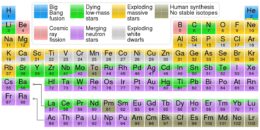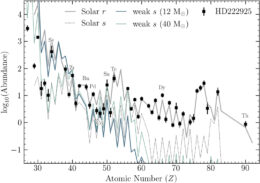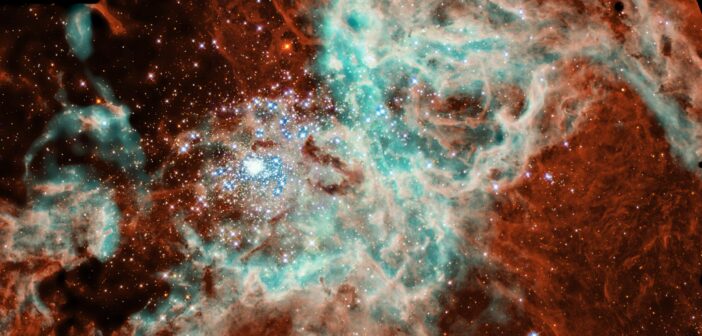From its name alone, HD 222925 is no different from the 350,000 other stars in the Henry Draper Catalogue. What sets it apart is how closely we’ve studied it: we’ve measured the abundances of more elements in HD 222925 than any other star except for the Sun. This makes it an excellent target for studies of how stars inherit chemical elements from their birth environments.
Making Heavy Metals

Periodic table of elements showing the likely origin of each element in our solar system. Click to enlarge. [Wikipedia user Cmglee; CC BY 3.0]
Since stars form out of the gas left behind by previous generations of stars, the relative amounts of r-process elements in a star’s spectrum can tell us about the events that preceded it. In comparing HD 222925’s chemical abundance pattern to the Sun’s, researchers found that while the stars have similar heavy-metal abundance patterns overall, their patterns differ among the lighter r-process elements.

Comparison of HD 222925’s abundance pattern (black squares) to the Sun’s abundances due to slow neutron capture and rapid neutron capture, denoted s and r, respectively. Click to enlarge. [Holmbeck et al. 2023]
Going for the Gold (and Platinum and Iridium and…)
Researchers often model the Sun’s abundance pattern to test their understanding of how events like neutron star mergers create r-process elements. However, HD 222925 is older than the Sun and has a smaller amount of metals — elements heavier than helium — than the Sun does. This could mean that HD 222925’s chemical makeup reflects the r-process elements created in a single cataclysmic event, like two neutron stars colliding, rather than containing material enriched by multiple events. This would make HD 222925 a better template for the chemical abundance pattern created by a single source of r-process elements.
To address this possibility, Erika Holmbeck (Observatories of the Carnegie Institution for Science) and collaborators used computational models to determine the likeliest source — or sources — for the pattern of chemical elements seen in HD 222925.
More Adjustments Necessary
Holmbeck‘s team found that it was challenging to reproduce some of the star’s elemental abundances with models that included only one source of r-process elements, but they found two possible ways to bring the model into better agreement with the observations. In the first, HD 222925’s light and heavy r-process elements come from two different sources. In the second, there’s only one source — neutron star mergers — but conditions must be tuned in a very specific way so that the energy released when atoms split apart into lighter elements doesn’t re-heat the surrounding material and prompt further fusion.
While these options could explain HD 222925’s observed chemical abundances, the authors suggest that we might just need to pin down certain physical quantities used by the model more precisely. Regardless of the answer, there’s more work to be done — either laboratory work, improvements to our models, or making more measurements of metal-poor stars to understand if HD 222925’s chemical abundances are representative of metal-poor stars as a whole.
Citation
“HD 222925: A New Opportunity to Explore the Astrophysical and Nuclear Conditions of r-process Sites,” Erika M. Holmbeck et al 2023 ApJ 951 30. doi:10.3847/1538-4357/acccf3

